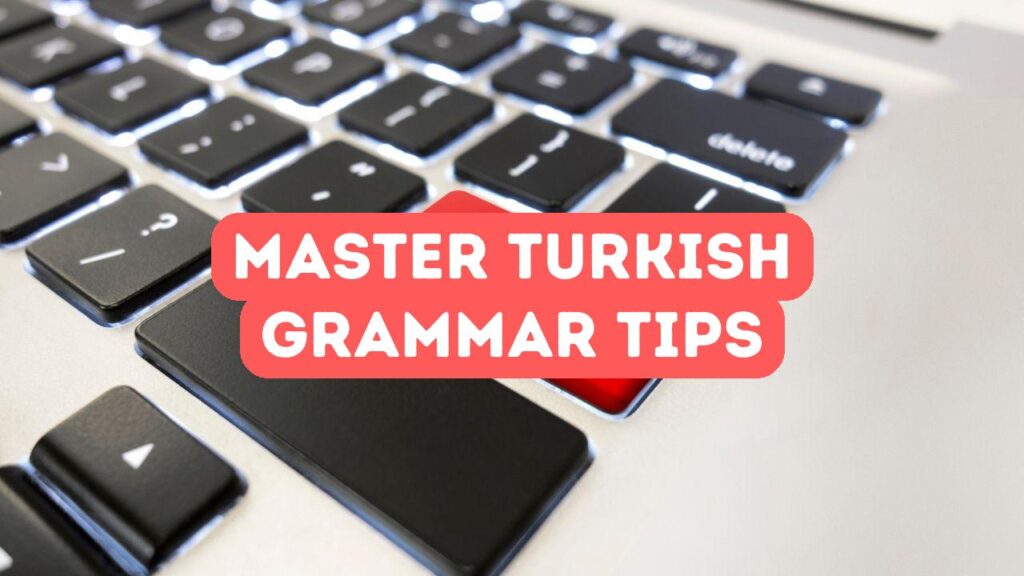Mastering Turkish grammar may seem daunting at first, but with the right approach, it becomes an achievable goal for foreign students. Turkish grammar tips can serve as your compass in this linguistic journey. Imagine navigating a vast maze, where each twist and turn brings you closer to fluency. Turkish, with its agglutinative structure, might catch you off guard with its unending suffix combinations. But don’t fret! By breaking down complex Turkish grammar rules into manageable pieces, you’ll steadily climb the mountain of mastery. Remember, the key to success lies in consistency. Regular practice will boost your confidence and deepen your understanding. This isn’t just about learning Turkish grammar; it’s about immersing yourself into a rich tapestry of language and culture. So, strap on your boots, foreign students seeking to master the Turkish language, because the path to fluency is paved with persistence and a touch of curiosity.
Essential Grammar Rules Every Learner Should Know
Turkish grammar rules form the backbone of effective communication, laying out a road map for foreign students to follow. To master the Turkish language, it’s vital to grasp essentials like vowel harmony and word order. Did you know that word order in Turkish is typically subject-object-verb? This will be different from what you’re used to, but adapting to it opens new avenues for expression. Additionally, the idea of suffixes stacking to change meaning might be foreign, yet it’s a key aspect of learning Turkish grammar. These suffixes attach to root words like puzzle pieces, transforming sentences with precision. Consistency births clarity, so frequent practice will have grammar quirks turning into second nature. Let these Turkish grammar tips be your guiding star, ensuring that each rule you learn builds a sturdy foundation, enhancing not only your language skills but also your connection to Turkish culture itself.
Understanding essential Turkish grammar rules is a stepping stone to fluency, especially for foreign students diving into this vibrant language. One fundamental rule revolves around vowel harmony—a melody within words that ensures vowels flow smoothly together. Can you hear the rhythm? Mastering vowel harmony from the outset helps foreign students Turkish speakers sound more natural. The Turkish language dances with suffixes, an integral part of its grammar. These suffixes modify nouns, adjectives, and verbs, creating a symphony of meaning. As you learn Turkish grammar, you’ll encounter these suffixes frequently, learning to wield them with skill to master the Turkish language. Another golden rule is verb conjugation, essential for conveying time and intention in every sentence. Grasping these conjugations opens doors to expressing future, present, and past actions with ease. These core components not only sharpen your linguistic skills but also deepen your engagement with Turkish culture, bridging the gap between language learner and local speaker.
For foreign students Turkish learners, delving into the Turkish grammar rules reveals secrets pivotal to fluency. Dive into the structure of word order—discover how moving from subject-object-verb to a crafted sentence unfolds layers of meaning. Behind each rule lies a method to the linguistic madness. Consider possessive suffixes; they weave ownership directly into nouns, eliminating the need for extra words. As you learn Turkish grammar, the compound tenses become vital—they enable expressions beyond the simple past or present, opening windows to complexity and nuance. These essential grammar rules serve as milestones in your journey, each conquering step closer to fluency. Consistent practice of these rules helps foreign students Turkish learners become intuitive speakers, making Turkish grammar tips a valuable ally. Embrace the power of these guidelines and you’ll master Turkish language intricacies with ease and connect more deeply with the culture that speaks through its grammar.
Common Mistakes to Avoid in Turkish Grammar
Understanding the common pitfalls in Turkish grammar is crucial to avoiding repeated errors. Foreign students often stumble over vowel harmony and word order, two fundamental aspects of learning Turkish grammar. It’s like trying to assemble a puzzle where the pieces seem to fit but don’t quite create the right picture. Imagine saying “evler güzel” when you intended “güzel evler”—a simple switch that changes meaning entirely. Turkish grammar tips emphasize the importance of paying attention to these details. Many learners also trip over the extensive use of suffixes, mistakenly thinking “-lar” always means plural, overlooking context. By concentrating on these Turkish grammar rules, foreign students can dodge these traps. Remember, mastering the Turkish language doesn’t happen overnight. A keen eye for such details ensures that mistakes become stepping stones, not roadblocks, on your journey to fluency.
A frequent blunder among foreign students learning Turkish grammar is neglecting the tricky vowel harmony. Think of it as a dance, where vowels must move in harmony with one another. Missteps in harmony often disrupt the flow, like a stumbling dancer. Turkish grammar tips often warn about this, showcasing its importance. Additionally, the placement of adjectives and nouns regularly confounds learners. Picture speaking of “ev güzel” instead of “güzel ev,” confusing the listener’s mind. Such mishaps in these Turkish grammar rules can alter the meaning entirely. Comprehending the nuances of vowel harmony and word placement is pivotal. Setting a strong foundation ensures every sentence you build is sturdy and sound. Ultimately, a strong grip on these essentials propels you forward on your quest to master the Turkish language. Embrace these fundamentals, turning potential pitfalls into valuable lessons.
Many foreign students Turkish encounter challenges due to the pervasive influence of their native language on their learning. These errors often surface in unexpected ways. For example, direct word-for-word translations can stumble over Turkish grammar rules. Imagine attempting to apply English sentence structure to Turkish—suddenly, clarity dissolves into confusion. Turkish grammar tips repeatedly highlight this issue, offering strategies to bridge gaps. Another pitfall is neglecting context, especially with verb tenses. Relying solely on methods used to learn Turkish grammar elsewhere might lead to awkward phrasing. Mastering the Turkish language demands adaptability, not rigidity. To truly grasp the subtleties, students should embrace flexibility. By observing native speakers or reading authentic Turkish texts, learners can internalize proper structures. Let every mistake be a stepping stone. In this linguistic dance, these lessons play a vital rhythm, guiding you ever closer to fluency.
Practical Exercises to Enhance Your Skills
Practical exercises are your best allies when you learn Turkish grammar. Foreign students often find that practicing with real-life examples makes Turkish grammar rules easier to grasp. Consider transforming your favorite short story into Turkish or composing simple daily journals. These tasks serve as a playground, allowing you to experiment and apply Turkish grammar tips actively. Partner up with a fellow learner or join a language club to share your experiences. Engaging in dialogues or writing simple scripts will also help you to master Turkish grammar nuances. Remember, repetition shapes excellence. Regularly practicing these exercises builds a sturdy framework in your mind, helping you lay bricks of confidence along your path to fluency. Every attempt constructs a more vivid picture of the Turkish linguistic landscape, clearing the fog of uncertainty. Keep this momentum going; the more you play with the language, the clearer the grammar becomes.
Incorporate Turkish grammar tips into your daily routine by focusing on listening and speaking activities. For foreign students Turkish offers a wealth of multimedia resources that can aid in understanding the language’s rhythm and structure. Listen to Turkish podcasts or watch Turkish series with subtitles to immerse yourself in authentic conversations. Try to mimic the intonation and pronunciation you hear. Engaging in role plays where you simulate everyday situations allows you to practice using Turkish grammar rules in context. Hold mock conversations about ordering food or asking for directions with your peers. Even if mistakes slip through, each session reinforces your grasp of the language. This active engagement helps you master Turkish language patterns, embedding them into your memory naturally. Through these auditory exercises, you’ll gradually learn Turkish grammar, breaking down its complexities into familiar beats that become as intuitive as your native language.
Dive into interactive tools and apps designed to teach and reinforce Turkish grammar rules. These platforms are a treasure trove for foreign students aiming to master Turkish language intricacies. You can customize your learning experience with games and quizzes tailored to focus on specific weak points. Use flashcards to memorize essential grammar terminologies, or voice recognition features to refine your pronunciation. Everything counts when you’re on a quest to learn Turkish grammar. Keep a language diary, jotting down new tips and phrases you encounter daily. This habit will cement Turkish grammar tips into your memory, transforming theory into practice. Join online forums or social media groups where learners exchange ideas and clarify doubts. A sense of community fosters greater engagement and motivation. Remember, every little step propels you forward on this adventure to master Turkish language fluency.







